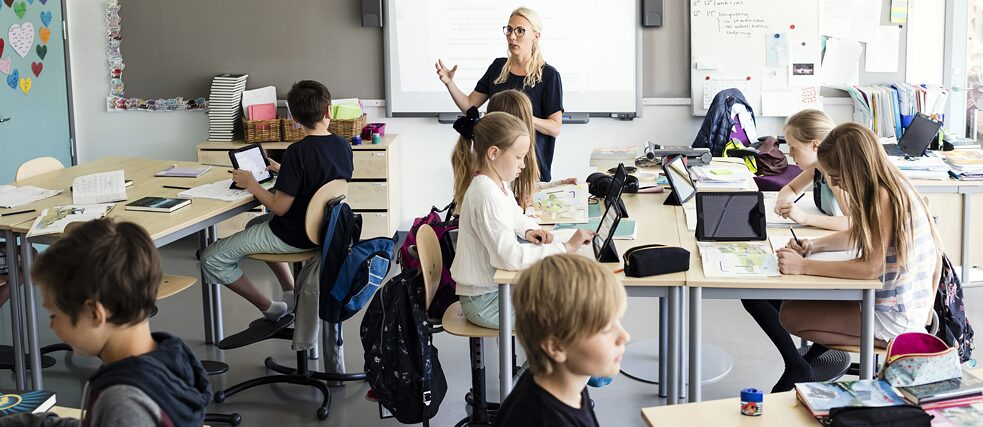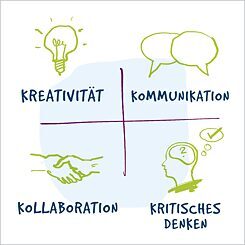Practical tip: Post-pandemic Teaching
New dimensions of teaching: Some suggestions for modern-day teaching

© Goethe-Institut/GettyImages
When the pandemic broke out, teachers had to find their feet on unfamiliar terrain virtually overnight. Now that things are “back to normal”, what do we want the “new normal” to be and what are the insights for modern-day teaching?
By Christiane Bolte-Costabiei und Stefan Häring
The pandemic shook up the education system and made it clear that we need a new (more complex) teaching culture with new learning environments. Furthermore, the heated controversy lately over ChatGPT and other AI technologies goes to show how social and technological developments are posing a fundamental challenge to traditional teaching practices.
(Almost) everything has changed
When it came to switching from in-person to online teaching during the pandemic, language teachers found it a reassuring experience to be able to apply many familiar elements of analogue teaching to online teaching: the systematic structure of coursework, evaluation; switching methods for different teaching purposes; working in various social forms; applying methodological didactic principles in class and a whole lot more.But they also found that analogue teaching doesn’t translate one to one to digital teaching. Teaching approaches need to take specific conditions of digital learning into consideration: e.g. different physical spaces; the coexistence and intertwining of everyday life, work and learning; the lack of social contact in the initial phase; the instant availability of digital tools and aids; a shorter attention span; the teacher’s reduced field of view; and the diversity of learners’ technical and social pre-dispositions.
After these experiences, many teachers were happy to get back to normal, but soon realized it wasn’t the old normal: things had changed, the pandemic had exposed shortcomings in education systems all over the world, and they have to rethink their approach to teaching accordingly.
All of which will make the next few years particularly challenging and exciting, not least because everyone involved can contribute to designing and fine-tuning novel approaches to teaching and learning.
Focussing on learners
Learners who were already accustomed to and comfortable with learning on their own had an advantage during the pandemic. Most learners, however, were not equal to the demands of this new way of learning in a new learning environment and had a hard time getting through the material on their own. So, to meet the challenges of a rapidly changing society and ongoing technological developments, it’s more important than ever nowadays for teachers to encourage autonomy and to work self-directed learning into their courses.
Teachers should also bear in mind the heterogeneous makeup of their classes, which are becoming increasingly diverse owing to a number of different factors. So it’s increasingly important to take the needs and strengths of individual learners into account. The use of digital tools and flexible online/offline settings can help to create an inclusive learning environment that will support the individual development of each and every learner.
Practical tips:
- Allow time in class for learners to think about their own learning. Have them engage in reflection sessions with partners or peer groups to address questions about the subject matter you’ve been covering.
- Use creative projects and plenty of group work to encourage collaboration and communication.
- (Re-)design tasks to encourage critical thinking and creativity through discussion and problem-solving.
- Assign cognitively challenging tasks that call for critical thinking, even for learners at low levels of language proficiency.
- Carefully assess the diverse needs and abilities of the learners. Consider which tools are most helpful to support and challenge them.
- Supplement your teaching materials with various tasks suited to learners’ different needs and abilities. This often requires very little effort.
Teaching methods and settings
During the pandemic, many teachers improved their skills in the use of digital tools and applications – and pretty rapidly at that. The important thing now is to keep this development going, to integrate digital tools into analogue in-person learning in the classroom, and to implement multimedia tasks that allow for different forms and ways of working. Apps also make for variety and accommodate the habits and needs of young learners.This approach enables learners to work on tasks in various ways: using social media, AI-based apps, digital storage systems or other technologies. To allow for disparities in learners’ technical and social skills, teachers should consistently take pains to be responsive to their individual needs and capacities and give them opportunities to work together with their peers.
Practical tips:
- Integrate digital devices as well as tasks and exercises involving digital tools into your instruction. Most of them can be used in several different phases of the lesson, so all you need is a limited selection of digital tools and apps.
- Allow for different ways of working. For example, let learners decide which form and medium they want to use to put together a text or other final product.
- Work with your colleagues to arrange the classroom in a flexible way that allows for rapid switching to collaborative activities. If this is not possible, practise rearranging the classroom quickly with your learners.
Teaching and learning settings
Digital teaching and learning settings can help to diversify and personalize teaching. On- and offline activities can be variously combined:Blended learning combines traditional in-person teaching methods with digital learning activities. Learners can go online to access learning resources and consolidate what they’ve learnt in class, which leaves more time in class for discussion, exercises and individual support.
Learning platforms and learning management systems (LMS) serve to organize and pool course material, tasks, tests, and communication tools.
In what’s known as a “flipped classroom”, learners familiarize themselves with a given topic before class e.g. by watching videos or reading articles posted online. Then, in class, they go into it in depth, clear up any questions and do exercises together. By “flipping” the traditional order in how subject matter is learnt, teachers can use class time more effectively to address individual needs and help learners apply what they’ve learnt.
Mobile learning enables learners to access content via mobile devices like smartphones or tablets.
To boost motivation, you can work playful activities into the learning process (“gamification”), such as educational games, quizzes and contests.
These various teaching and learning settings can be varied and combined in a sensible way according to learners’ needs and goals and the basic framework in which a given class is conducted.
Practical tips:
- Rearrange your teaching/learning settings to vary the options provided by your institution.
- Make collaborative homework available to your learners on learning platforms and synchronous communication tools.
- Provide instructive content for learners to work on individually according to the “flipped classroom” principle.
- Provide detailed and constructive feedback both orally and in writing. Consultation sessions, audio recordings and screencasts can also be used for rapid feedback, even outside of class.